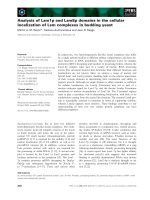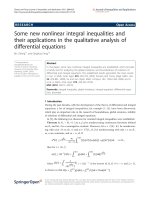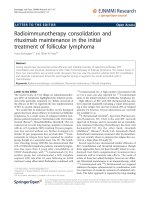Reactionary Philosophy and Ambiguous Aesthetics in the Revolutionary Politics of Herbert Marcuse—A Review Essay pptx
Bạn đang xem bản rút gọn của tài liệu. Xem và tải ngay bản đầy đủ của tài liệu tại đây (177.59 KB, 9 trang )
Nature, Society, and Thought, vol. 16, no. 2 (2003)
1
Book Review
Reactionary Philosophy and Ambiguous
Aesthetics in the Revolutionary Politics of
Herbert Marcuse—A Review Essay
Ralph Dumain
Art, Alienation, and the Humanities: A Critical Engagement with
Herbert Marcuse. By Charles Reitz. Albany: State University of
New York Press, 2000. 336 pages, cloth $26.50, paper $25.95.
Charles Reitz’s essential contribution to the study of Marcuse
is his marvelous demonstration of how deeply Marcuse’s philo-
sophical framework is imbued with reactionary Lebensphilosophie.
While Reitz successfully locates Marcuse’s ideas in their original
European social and intellectual context, he fails to explain ade-
quately how Marcuse’s ideas function in the U.S. context. Though
chapter 10, presenting Reitz’s contemporary perspective, is disap-
pointing, this book is an outstanding achievement and indispens-
able for anyone interested in Marcuse.
Reitz points out that “Marcuse holds positivism and rational-
ism, rather than metaphysics or irrationalism, to be among the
more pernicious intellectual forces,” favoring “romantic opposi-
tional philosophies of protest like Lebensphilosophie” and fi nding
“a liberating negative, that is countercultural, value in Nietzsche
2 NATURE, SOCIETY, AND THOUGHT
and Schopenhauer” (114–15). Marcuse even fi nds a spirit of
negativity in traditional metaphysics and advocates a retooled
Platonism (153). Marcuse assigns an important role to imagina-
tion and the consciousness of death. The infl uences of Heidegger
and Nietzsche are pervasive.
Reitz provides an extensive analysis of Marcuse’s early
intellectual work, imbued with the weighty infl uence of Dilthey
(chapter 2). Marcuse was the fi rst to review Marx’s newly avail-
able 1844 manuscripts, but Dilthey and Heidegger determined
Marcuse’s reading of the young Marx (58–61). Marcuse was heav-
ily infl uenced by Lukács, whose notion of reifi cation is rooted in
German idealism, not Marx (65–66). Marcuse was concerned here
and elsewhere with reifi cation and the alienation of the human
essence, not historical materialism.
Marx is nowhere mentioned in the “critical” philosophical
discussion central to Eros and Civilization. There is also no
evidence to suggest that Marcuse’s “philosophical inquiry
into Freud,” . . . occurs on the basis of a Marxist philosophi-
cal analysis. Quite to the contrary, it appears that Marcuse
turns primarily to Nietzsche’s critique of the traditional
metaphysics in this regard. (126)
Culture and aesthetic ontology
Reitz is troubled “by the way in which Marcuse’s theories of
art, alienation, and the humanities displace Marx’s structural analy-
sis of social life to such an extent that the former’s work also takes
on ironically conservative political overtones.” Reitz concludes
that Marcuse’s concept of reifi cation is “ultimately detached from
the materialist context of the Marxist economic analysis” (7–8).
Art, alienation, and the humanities (humanistic education)
coalesce as the decisive themes of Marcuse’s lifelong work.
Marcuse pitches his philosophical tent in the humanities, demar-
cated from the world of science and technology. In his “militant
middle period” (approximately 1932–1970), he promotes an edu-
cational activism in opposition to traditional aestheticist quietism,
to which he reverts in this third period (11–12). His questionable
philosophical foundations are rooted in the Frankfurt School’s
Complementarity: Dialectics or Formal Logic? 3
conception of alienation as reifi cation.
After 1933, Marcuse shifts his affi liation from Heidegger to
the Frankfurt School. Marcuse bases his investment in critical
theory on utopianism, not scientifi c objectivity (81). His aesthetic
conceptions undergo a shift in his second period, decisively reg-
istered in his 1937 essay “The Affi rmative Character of Culture.”
Here he attacks the quietism of the traditional role of culture,
advocating instinctual gratifi cation—not just the liberal arts, but a
reshaping of life and experience (81–84). Even in this most pro-
gressive period, his aesthetic ontology is predicated on an aes-
thetic rationality (as opposed to science) that negates the existent
(106–7). Marcuse’s “dialectic” is Romantic negation, a concep-
tion rooted in dualism, not historical materialism (109).
High culture, popular culture, and politics
Reitz rightly sees a lasting contribution in Marcuse’s notion
of repressive desublimation brilliantly articulated in One-
Dimensional Man (144). In 1964, Marcuse concluded that popular
culture had obliterated the negative, that the disjunction between
culture and the social order was closed, no longer to be disrupted
by unruly outsiders (149). Reitz’s neglect of a comparison between
that period and today augurs a fundamental defect in his conclu-
sions about the present.
In his 1967 lecture “Art in the One-Dimensional Society,”
Marcuse emphasizes the liberatory power of art against the pro-
saic routine of daily life. He argues that revolutions in art and
culture—manifestations of the rebellious spirit of the aesthetic
imagination—can fuel social-protest movements, especially in
today’s advanced technological society, in spite of the danger of
cooptation (166–71). Reitz interjects a perplexing criticism:
In contradistinction to dialectical materialism, Marcuse
preserves here a dualistic conception of the relationship of
politics to art (as “extraneous activity”). While aesthetics
must inform politics, Marcuse is adamant in emphasizing
throughout his middle period that “the real change which
would free men and things, remains the task of political
action.” Marcuse’s major contention in this essay is, how-
4 NATURE, SOCIETY, AND THOUGHT
ever, that no negation of the alienating conditions of social
existence is even possible apart from the emancipatory
potential of the aesthetic dimension.(173–74)
While highlighting a possible contradiction in Marcuse’s pro-
gram for the aesthetic emancipation of social life, Reitz is unclear
about what is precisely wrong with Marcuse’s view of the division
of labor between art and instrumental politics. Perhaps this confu-
sion is a foreshadowing of what will go wrong in chapter 10.
Education, reifi cation, and social change
Marcuse’s views come closest to revolutionary politics in his
1969 book, An Essay on Liberation, when student activism was at
its height. Lukács and Marcuse both saw the necessity for a new
form of reason to serve an educative function in the struggle against
reifi cation. Unlike Lukács, Marcuse adopted Schiller’s principle
of aesthetic education, directing education not against capitalism,
but against the reifi cation of reason (177–79). Marcuse incorpo-
rated psychoanalysis into educational and aesthetic theory (180).
Reitz is correct to criticize Marcuse’s substitution of the dialectic
of aesthetically conceived forces for the conceptual apparatus of
historical materialism and class struggle, but he detracts from the
validity of his argument by opposing Marcuse’s aesthetic ontol-
ogy to the historical-materialist philosophy of art (181), injecting
a philistine leftist approach to art into the discussion.
While Marcuse’s reversal of the position of his middle period
is clearly marked in his 1978 The Aesthetic Dimension, precedent
for it can be found in his 1972 Counterrevolution and Revolt.
Marcuse presents essentially “a favorable reappraisal of the valid-
ity of the culture of the bourgeois era.” He speaks of art as a “sec-
ond alienation,” which is “emancipatory rather than oppressive.”
Here, the affi rmative character of art itself is thought to
become the basis for the ultimate negation of this affi rma-
tion. Affi rmation represents a dimension of withdrawal and
introspection, rather than engagement. This permits the art-
ist to disentangle consciousness and conduct from the con-
tinuum of fi rst-dimensional alienation, and thus to create
and communicate the emancipatory truth of art.” (197)
Book Review 5
Marcuse is convinced that overtly bourgeois art—because
it is art—retains a critical dimension, and should, itself, be
regarded as a source of sociopolitical opposition to domina-
tion. Marcuse maintains in fact that the art of the bourgeois
period indelibly displays an antibourgeois character, and in
this manner he rejects the orthodox Marxist emphasis on
the class character of art. (198)
Marcuse also criticizes the “living-art” and “anti-art” ten-
dencies that he associates with the politically progressive
art of the leftist-oriented “cultural revolution,”’ as repre-
senting a “desublimation of culture” and an “undoing” of
the aesthetic form . . . Marcuse explicitly turns away from
the immediacy of sensuousness and militance characteristic
of his own middle-period aesthetic. (198)
There may well be abstract justifi cation for Marcuse’s posi-
tion, but the warrant for immediacy or critical distance must sure-
ly depend on particular circumstances. Without a detailed analysis
of the aspects of the counterculture of the 1960s to which Marcuse
specifi cally reacted, there is no way of judging his position. Is
there a generational issue here? Could Marcuse have been too tra-
ditional, too elitist and European, or did the counterculture merit
such criticism? Reitz’s total failure to address this crucial question
contributes to the central fl aw in his book. Reitz only hints at a
few cultural expressions of the 1960s that Marcuse condemned.
On the other hand, it seems that Bob Dylan joins the august com-
pany of Joyce, Beckett, and others in standing up for art-as-alien-
ation (199). Marcuse reverses his former critique of affi rmative
high culture against the attempt of the countercultural revolution
to eradicate it (202). Again, nothing could be more crucial than a
detailed analysis, but Reitz has nothing to offer here.
In his last book, The Aesthetic Dimension, Marcuse opposes
Marxist aesthetics and argues for the permanent value of art (204–
6). Marcuse has returned to his earliest ideas. There is a dualism
between art and society; art is permanently incompatible with life.
Art is inherently alienated and rebels against the established real-
ity principle (210). Marcuse’s conception of education is affected
6 NATURE, SOCIETY, AND THOUGHT
also, as he attempts to deploy the notion of “educational dictator-
ship” to oppose an otherwise hopelessly reifi ed reality (215–16).
Marcuse argues for the universality and permanence of the
classics. Aesthetic “stylization reveals the universal in the particu-
lar social situation.” The historical content of an artwork becomes
dated, but the universality of the forces represented transcends
the particular history (217–19). While it is clear that the aesthetic
ontology supporting Marcuse’s judgments is highly questionable,
it is not immediately evident that his aesthetic principle is wrong.
This is an important distinction that Reitz does not make. Specifi c
examples must be analyzed. Since Marcuse’s death, in the culture
at large and in the specialized world of cultural criticism, cultural
and social assumptions have altered so drastically that we are now
aware of the vast discrepancy between our assumptions today and
those current in former times and even when Marcuse wrote in the
1970s. A sophisticated analysis of what is permanent and what is
dated in works of art is needed, but apparently Marcuse did not
provide it, nor does Reitz.
In sum, an analytical distinction should be drawn between
Marcuse’s aesthetic ontology and some of his stated aesthetic
principles or judgments, and between the latter and his politics.
The missing link: Marcuse and U.S. culture
The most glaring omission in Reitz’s presentation is an analy-
sis of the links connecting Europe of Marcuse’s youth and the
United States today. We see Marcuse’s intellectual and cultural
socialization in Europe, and the circumstances of his radicaliza-
tion with the conservative ideological baggage he inherits. Then
as an émigré living in the United States, he develops his ideas
further in an altered context. Emerging from the repressive 1950s,
Marcuse makes his closest approach to a popular movement at
the height of the protest movements of the 1960s, then retreats as
revolutionary hopes recede. We require, however, an assessment
of the transplantability of ideas based on a European cultural heri-
tage to American conditions.
Why did the youthful revolutionary generation of the 1960s
fi nd Marcuse’s ideas so congenial? Does the reactionary, irra-
tionalist Lebensphilosophie that Marcuse imbibed intersect with
Book Review 7
the very different youth culture of the sixties on the basis of the
latter’s primitivist, escapist, instinctualist tendencies? Do the two
then diverge because the latter was putting into practice what the
former could only theorize? What did the students who studied
Marcuse think of his reactionary Lebensphilosophie? What did
they think of the irrationalist, New Age currents in their own gen-
eration?
When avant-garde and popular culture are contrasted, the
issue of art as immediacy vs. alienation enters. I do not fi nd the
rigid opposition that grew out of the European context adequate to
American conditions. (Consider the history of jazz, for instance.)
There is no a priori way to decide when a principled refusal to
participate in compromising cultural forms is warranted. When is
participation in popular forms possible without being swallowed
up by the mechanisms of the culture industry? Is it even possi-
ble now for an avant-garde to deploy alienation effects to break
through the wall of commodity fetishism, conformity, and false
values? The old avant-gardes were squeezed dry to feed the popu-
lar culture of the present; no technique seems to be left by which
to defamiliarize the taken-for-granted.
It is astounding that Reitz, who experienced the generational
cultural shifts of both the 1960s-70s and the 1980s, fails to pose
any of these questions. How can the baby boomer intellectuals’
amnesia about their own history be accounted for?
The future
Chapter 10 asks how the “critical” in critical theory can be
liberated. Reitz summarizes the ways in which Marcuse dissoci-
ates himself from the traditional concerns of Marxism, but here he
adds “the identifi cation of revolutionary art and education with the
cultural forms actually experimented with by communist societ-
ies” (224). What can he mean by “communist societies”? Have
any existed? Can Reitz have in mind the Soviet Union, since he
criticizes Marcuse’s analysis of Soviet education and aesthetics
(157–63)? Or perhaps Mao’s China?
Following Mitchell Franklin’s lead, Reitz argues that
Marcuse is a “beautiful soul” in Hegel’s sense, essentially dual-
ist and incapable of overcoming contradiction (228). Reitz also
8 NATURE, SOCIETY, AND THOUGHT
documents the sense of betrayal that radical activists felt towards
Counterrevolution and Revolt, taken to be a call for postponement
of revolutionary action (229). Reitz is guilty of two signifi cant
omissions here. First, he assumes that Marcuse’s stance was the
direct result of the quietism implicit in his underlying ontology
and the vacillation inherent in his dualism. The second omission is
even more glaring: an uncritical attitude toward the student radi-
cals and the ultraleftist revolutionism of the time. Could Marcuse’s
pessimism have had sound reason?
Reitz is quite correct that an ontological, abstract philosophical
anthropology cannot adequately cope with the specifi city of his-
torically occurring social and cultural forms (234). He has little to
offer, though, in delineating the dialectical materialist alternative
to cultural analysis, except to cite some of its stodgiest representa-
tives. He takes this opportunity to attack essentialism by quoting
some fashionable ideas and thinkers of the current postmodern
dispensation (235–42), not a move that inspires confi dence. Reitz
wants to preserve the “militant and adversarial dimension of
Marcuse’s philosophy,” but adds nothing about what there is in it
worth preserving except for its militant and adversarial moments
(243, 246).
The assumptions behind the academic activist agenda that
Reitz advocates need to be critically examined, and the fruitful
proposals sifted from the unconvincing social-service rhetoric
so characteristic of the middle class professional, activist or not.
How is it possible that Reitz combines such brilliant analysis of
Marcuse’s philosophy with such blithe gullibility in an attempt
to make it more politically relevant? Again, the missing link is
the failure to analyze the application of Marcuse’s European ideas
in the American context. The failure lies in the silence about the
relationship of these ideas to the 1960s student generation beyond
the congruence or rift between Marcuse’s advocacy or quietism
and the students’ activism. Finally, I conjecture that there is a fail-
ure here of the sixties generation to mature and to disentangle a
century of confusion over the relation of intellectual and cultural
work to political practice.
My harsh evaluation of the fi nal chapter should not distract
Book Review 9
unduly from my overall commendation of the book. The book’s
shortcomings refl ect the lack of opportunity for meaningful dia-
logue in this society. I urge the reader to use this invaluable book
as a springboard for further discussion.
For a more detailed critique, see my unabridged draft of this review
at
/>Washington, D.C.









